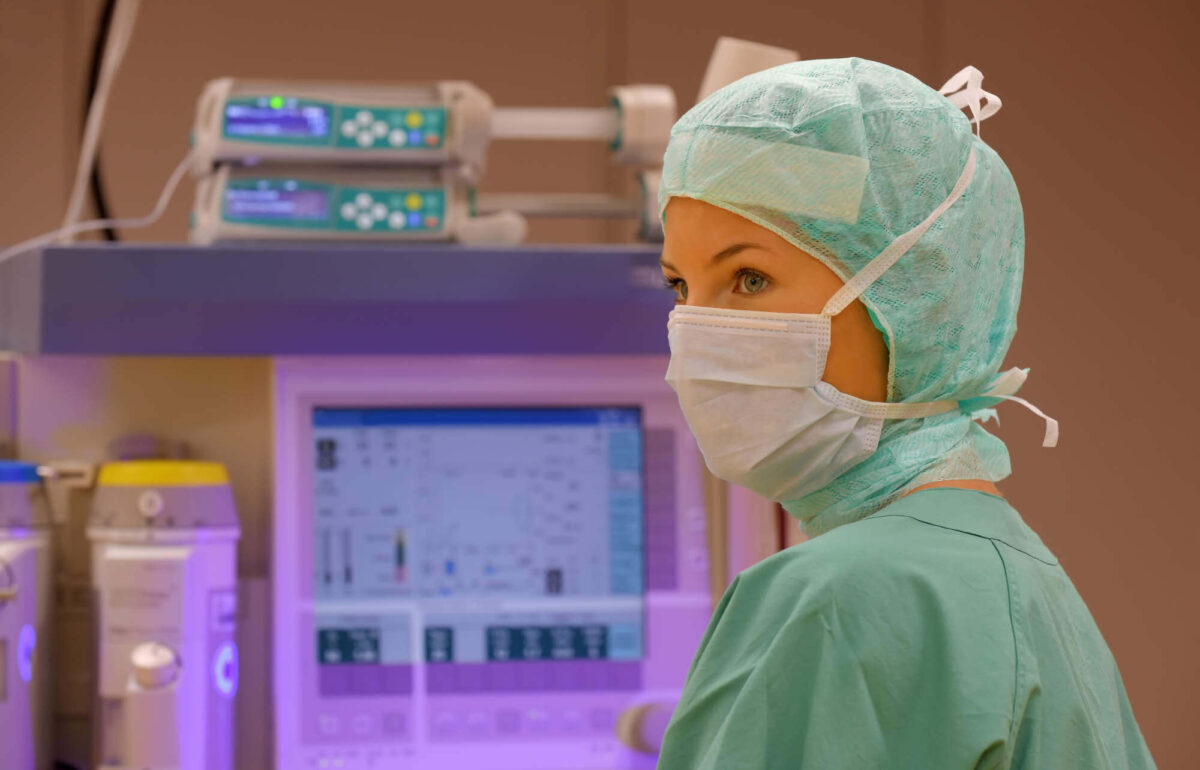The Evolution of the Anesthesia Machine

A quick glance around a typical household kitchen reveals a surprising truth: contained therein are the founding mechanisms used to administer anesthesia. The humble beginnings of sponges, towels, and handkerchiefs have evolved into the computerized self-sufficient anesthesia machines used today.
William Morton, a dental surgeon, publicly demonstrated the first successful pain-free surgery using ether anesthesia in 1846. For delivery, he used a glass globe with two valves for the inhalation and diffusion of ether vapor as air circled through. The contraption contained a sponge soaked in ether liquid for expanding the evaporation surface [1]. However, there loomed dangers of uncontrolled ether concentrations and varying amounts of anesthesia required for sedation [2]. Chloroform, a liquid anesthetic, decreased the heart rate more than ether, making it crucial to find a method for controlled administration [3]. By 1847, physician John Snow devised a machine to control vapor pressure using water to stabilize temperature and metal spiraled air passages to saturate ether. With many doctors unwilling to give up simplistic methods and learn complex apparatuses, Snow’s invention of a controlled ether inhaler was largely ignored [4].
Nitrous oxide gas catalyzed a turning point for anesthetics. Its harmless ability to stimulate rather than depress the nervous system and to quickly sedate without irritating the lungs, trumped the risks of ether and chloroform [5]. In 1865, a dental company began manufacturing impractical appliances requiring the immense efforts of holding a wooden mouthpiece while plugging patients’ noses to inhale gas from a bag. Liquid-form nitrous oxide avoided these nuances and began being sold in cylinders attached to a maze of bags, valves, and a mask [6]. To counteract the lack of oxygen in this arrangement, physiologist Paul Bert designed a hyperbaric pressure chamber providing 15% oxygen and 85% nitrous oxide but was unaware of oxygen toxicity at high pressures [7]. Eventually, the dental company’s initial flawed gas bag was redeemed with one of the first representations of an anesthesia machine. With pressure-regulating valves directing gas into a mixing chamber for oxygen and nitrous oxide, patients were safely sedated [4]. A milestone in medicine, anesthesia began transforming into a working machine.
The next century, anesthesia machines faced the challenge of accurately measuring gas concentration and flow. Initially, flow meters were used that relied heavily on the human eye to measure flow pressure based off of bubbling rates of water and moving bobbins. Gradually, rotameters replaced these, allowing medical professionals to self-calculate flow rate from the force of gas exertion. To preserve gas emissions from flow meters, pressure-controlled ventilators were introduced, depending on patients’ lungs to drive pressure and volume flow, but human error still remained [8].
In 1950, Snow’s achievement of temperature stabilization was implemented in new vaporizer designs. Now, delivery of liquid anesthesia depended only on flow rate and temperature. Though “variable bypass vaporizers” eliminated human calculation, they still required manual control to adjust concentrations [4]. With promising results from a computer-controlled anesthesia machine demonstration in 1978, manually operated vaporizers became computer- powered. Monitor feedback directed vaporizers to pump the amount of liquid anesthetic needed for specific vapor concentrations, offloading manual work — and marking the beginning of the twenty-first century.
With corporations releasing different prototypes, hospital workers spoke of “spaghetti syndrome,” as they jumbled up an array of cords from various machines [9]. Responding to these outcries, companies introduced monitors, anesthesia machines, and ventilators in one complete set to create the anesthesia workstation. From sponges to computers, the evolution of the anesthesia machine has now culminated in a single, portable, computerized station. Ideally, future evolutions will continue to safeguard the balance between computer and human responsibilities.
References
[1] Duncum B. (1994). The Development of Inhalation Anaesthesia. Royal Society of Medicine Press Ltd, London, 553-9, 106-8
[2] Bigelow, H. J. (1846). Insensibility during Surgical Operations Produced by Inhalation. The Boston Medical and Surgical Journal, 35(16), 309–317. https://doi.org/10.1056/nejm184611180351601
[3] J. Y. Simpson. (1958). New Anaesthetic Agent as a Substitute for Sulphuric Ether in Surgery and Midwifery, BJA: British Journal of Anaesthesia, Volume 30, Issue 11. 545 550, https://doi.org/10.1093/bja/30.11.545
[4] Eger, E. I., Saidman, L. J., & Westhorpe, R. N. (2014). Anesthesia Machines and Breathing Systems: An Evolutionary Success Story. The Wondrous Story of Anesthesia, 9781461484417, 703–714. https://doi.org/10.1007/978-1-4614-8441-7
[5] Weyde, V. (1864). Nitrous Oxide Gas. The New York Times. Retrieved from https://www.nytimes.com/1864/05/28/archives/nitrous-oxide-gas.html
[6] Thomas, K. B. (1976). The Development of Anaesthetic Apparatus. The 2 Oxide Series, 45(1), 74-103. https://doi.org/10.1097/00000542-197607000-00030
[7] Neuman, T. (2008). Physiology and medicine of hyperbaric oxygen therapy. Philadelphia, PA: Saunders Elsevier. 7-9
[8] Dorsch, J. A., & Dorsch, S. E. (2012). Understanding anesthesia equipment: Fifth edition. Understanding Anesthesia Equipment: Fifth Edition. 1–1056. Wolters Kluwer Health Adis (ESP).
[9] Westhorpe, R. N. (1992). The anesthetic machine in the 1990s. Anesthesiology Review. 46-55.